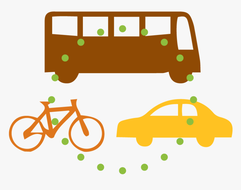|
By car, train, bike, bus, or simply on foot, the ways in which we choose to travel grants us the freedom to go where we want or need. Unfortunately, mode of transportation is not a choice for many. The expenses of purchasing and insuring a car, maintaining a bike, or the price of a bus or train ticket all limit the number of places and resources in which those experiencing poverty or homelessness can access. Low-income neighborhoods often lack fresh food grocery stores and jobs, meaning residents often have to travel further than those in wealthier areas to access food and work. Low nutrition, longer commutes, and a focus on physically inactive transportation increases stress and decreases health, making it harder to learn or work. The basic forms of transportation that people have access to make a huge difference in our cities and suburbs, where sprawling neighborhoods can invalidate walking, the only free form of transportation, as a viable means of accessing food, work, entertainment, or expanded social interaction.
While the simple existence of these modes of transportation creates barriers to those facing homelessness and poverty, the streets, bike lanes, and sidewalks used to facilitate transportation have historically facilitated homelessness, both intentionally and incidentally. Most notably, in the name of faster commutes and drivability, predominantly African American neighborhoods in most of our U.S cities have been dissected by highways, increasing access to city jobs and resources to suburbanites, but demolishing housing and cutting off interconnected roads for those in the city. In neighborhoods where wealth is more abundant and residents have more time to be involved in community projects, trails and sidewalks are more easily built and maintained, creating more space to be active and inviting businesses to the surrounding area. In low-income neighborhoods, sidewalks, if there are any at all, are often along busy streets with few barriers from cars, few traffic lights, and overall provide less protection for pedestrians. This, along with less greenery and chipped or cracked sidewalks, can discourage residents from relying on walking as a form of transportation, again, reducing access to public transportation, jobs, food, and physical activity, all of which perpetuate homelessness. In recent years in Chicago, a large focus has been placed on bike trails, in many initiatives to make the city’s transportation more eco-friendly. Bike trails can benefit communities both in health and economy, by providing safer spaces for physical activity and better access to more of the city. However, when bike trails are not interconnected throughout a whole city and have limited access points, typically just connecting high-income neighborhoods to other high-income neighborhoods, bike trails can have adverse effects on communities. Famously, the 606 trail, built mostly through private developers, gentrified the neighborhoods it was built through, forcing many to sell their homes to larger housing corporations with higher rents, pushing residents out of their homes. Today, the city of Chicago has started a new initiative, in which they plan to convert abandoned railroad tracks in Englewood into bike trails. Alongside this initiative, the city plans to give out 5000 free bikes, helmets and locks to residents. This project promises to be community led, aiming to avoid the pitfalls of the 606 Trail. The details of how this will be accomplished are still unknown, so it will be important for community members to stay up to date and involved with the process to make sure the promised resources go to those who need them.
0 Comments
|
BLogArchives
July 2024
Categories |
©2022 Chicago HOPES for Kids. All Rights Reserved.
Website by Gumbo Media
Website by Gumbo Media


 RSS Feed
RSS Feed
